
Lake Saint Pierre is a lake in Quebec, Canada, a widening of the Saint Lawrence River between Sorel-Tracy and Trois-Rivières. It is located downstream, and northeast, of Montreal; and upstream, and southwest, of Quebec City. The end of the lake delimits the beginning of the estuary of Saint Lawrence.

Agusan del Sur, officially the Province of Agusan del Sur, is a province in the Caraga region of the Philippines. Its capital is the municipality of Prosperidad. It is bordered on the northwest by Agusan del Norte and Misamis Oriental; east by Surigao del Sur; southeast by Davao Oriental; mid-south by Davao de Oro; southwest by Davao del Norte and, mid-west by Bukidnon.

Caraga, officially the Caraga Administrative Region, designated as Region XIII, is an administrative region in the Philippines occupying the northeastern section of Mindanao. The region was created through Republic Act No. 7901 on February 23, 1995. The region comprises five provinces: Agusan del Norte, Agusan del Sur, Dinagat Islands, Surigao del Norte, and Surigao del Sur; six cities: Bayugan, Bislig, Butuan, Cabadbaran, Surigao and Tandag; 67 municipalities and 1,311 barangays. Butuan is the regional administrative center.
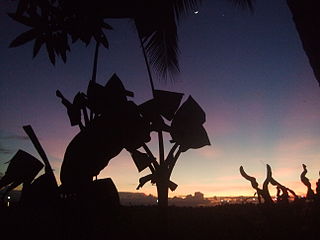
Bunawan, officially the Municipality of Bunawan, is a 1st class municipality in the province of Agusan del Sur, Philippines. According to the 2015 census, it has a population of 45,151 people.

Jabonga, officially the Municipality of Jabonga, is a 3rd class municipality in the province of Agusan del Norte, Philippines. According to the 2015 census, it has a population of 23,184 people.
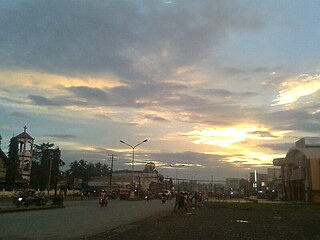
Bayugan, officially the City of Bayugan, is a 5th class city in the province of Agusan del Sur, Philippines with postal code 8502. According to the 2015 census, it has a population of 103,202 people. .
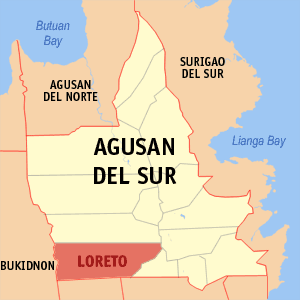
Loreto, officially the Municipality of Loreto, is a 1st class municipality in the province of Agusan del Sur, Philippines. According to the 2015 census, it has a population of 42,501 people.

Prosperidad, officially the Municipality of Prosperidad, is a 1st class municipality and capital of the province of Agusan del Sur, Philippines. According to the 2015 census, it has a population of 82,631 people.

San Francisco, officially the Municipality of San Francisco, is a 1st class municipality in the province of Agusan del Sur, Philippines. According to the 2015 census, it has a population of 74,542 people.

Veruela, officially the Municipality of Veruela, is a 2nd class municipality in the province of Agusan del Sur, Philippines. According to the 2015 census, it has a population of 43,706 people.
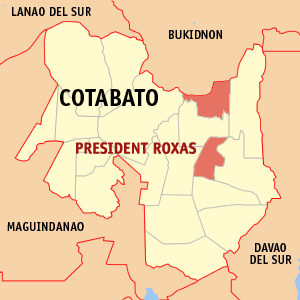
President Roxas, officially the Municipality of President Roxas, is a 1st class municipality in the province of Cotabato, Philippines. According to the 2015 census, it has a population of 47,575 people.

Nal Sarovar Bird Sanctuary, consisting primarily of a 120.82-square-kilometre (46.65 sq mi) lake and ambient marshes, is situated about 64 km to the west of Ahmedabad near Sanand Village, in the Gujarat state of India. Mainly inhabited by migratory birds in winter and spring, it is the largest wetland bird sanctuary in Gujarat, and one of the largest in India. It was declared a bird sanctuary in April 1969.

The Zapata Swamp is located on the Zapata Peninsula in the southern Matanzas Province of Cuba, in the municipality of Ciénaga de Zapata. It is located less than 150 kilometres (93 mi) southeast of Havana.
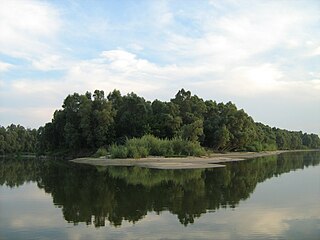
Gornje Podunavlje Special Nature Reserve is a large protected area of wetland in the northwest of Serbia, on the Danube's left bank. It comprises two large marshes, Monoštorski Rit and Apatinski Rit and vast forests, meadows, ponds, swamps and the Danube's meanders, including 66 km (41 mi) of the Danube course. It is projected as a part of the future trans-boundary biosphere reserve "Mura-Drava-Danube", a five country project, dubbed the "Amazon of Europe".

The Olango Island Group is a group of islands found in the Central Visayas region of the Philippines and is a part of Cebu Province. It comprises Olango island and 6 satellite islets namely: Sulpa, Gilutongan, Nalusuan, Caohagan, Pangan-an, and Camungi. Olango Island and its neighboring islets has a total land area of approximately 1,030 ha. The island group is divided under the jurisdiction of the city of Lapu-Lapu and the municipality of Cordova. It lies 5 km (3.1 mi) east of Mactan Island and is a major tourist destination in Cebu. It is known for its wildlife sanctuary. The entire area is the first declared Ramsar Wetland Site in the Philippines, as recognized in 1994.

Harike Wetland also known as "Hari-ke-Pattan", with the Harike Lake in the deeper part of it, is the largest wetland in northern India in the border of Tarn Taran Sahib district and Ferozepur district of the Punjab state in India.

Bundala National Park is an internationally important wintering ground for migratory water birds in Sri Lanka. Bundala harbors 197 species of birds, the highlight being the greater flamingo, which migrate in large flocks. Bundala was designated a wildlife sanctuary in 1969 and redesignated to a national park on 4 January 1993. In 1991 Bundala became the first wetland to be declared as a Ramsar site in Sri Lanka. In 2005 the national park was designated as a biosphere reserve by UNESCO, the fourth biosphere reserve in Sri Lanka. The national park is situated 245 kilometres (152 mi) southeast of Colombo.
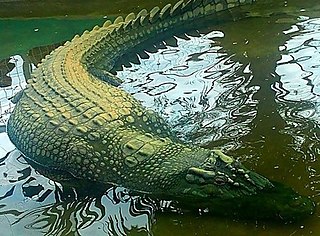
Lolong was the largest crocodile in captivity. He was a saltwater crocodile measured at 6.17 m, and weighed 1,075 kg (2,370 lb), making him one of the largest crocodiles ever measured from snout-to-tail.
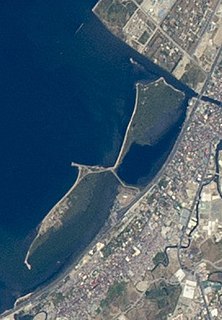
The Las Piñas–Parañaque Critical Habitat and Ecotourism Area (LPPCHEA), also known as the Las Piñas - Parañaque Wetland Park, is a protected area at the coasts of the cities of Las Piñas and Parañaque in Metro Manila, Philippines. The entire wetland is a declared Ramsar site under the Ramsar Convention of UNESCO.




















